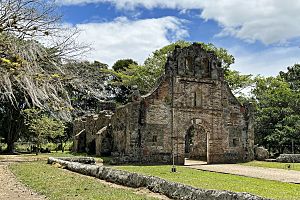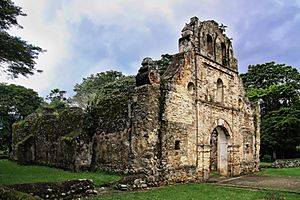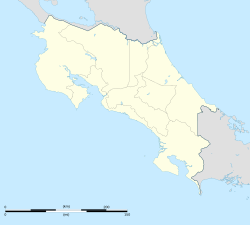Ujarrás facts for kids
Quick facts for kids
Ujarrás
|
|
|---|---|
|
Village
|
|
 |
|
| Country | |
| Province | Cartago Province |
| Canton | Paraíso Canton |
| District | Paraíso |
| Time zone | UTC-6 (Central Standard Time) |
| Climate | Am |
Ujarrás is a small village and an important historical place in the Orosí Valley of Cartago Province in central Costa Rica. It is located southeast of the city of Cartago. The village sits near the northeastern side of Lake Cachí, which is a man-made lake. This lake was created by building a dam on the Reventazon River, right next to the village. Ujarrás is also connected to Cachí, a town on the other side of the lake.
Contents
Exploring Ujarrás: Location and Surroundings
Ujarrás is found in the Paraíso district, within the Paraíso area of Cartago Province. It is nestled in a deep valley northeast of the town of Orosí, right by the Cachí Reservoir.
What You'll See in the Orosí Valley
The Orosí Valley is full of rivers and streams. You can see many coffee and flower farms here. Besides one of Costa Rica's oldest churches, other interesting places nearby include the Cachí Dam, the Tapantí National Park, and the Lankester botanical gardens.
The Rich History of Ujarrás
Ujarrás is home to the ruins of one of Costa Rica's oldest churches. Its full name is "Nuestra Señora de la Limpia Concepción del Rescate de Ujarrás." This church was built a long time ago, between 1686 and 1693, during the colonial period.
The Legend of the Virgin Mary
A local story says that native Huetar fishermen found a painting of the Virgin Mary in a box. They brought it to the village, and the church was built on that spot to honor the Virgin. Another version of the story says the image could not be moved, so the church was built around it.
At first, a simple hut made of straw was built. The local people called the Virgin Mary image "The Queen of the Valleys." This first structure was built between 1575 and 1580. Over time, the image became famous because many people believed it performed miracles for the villagers.
Protecting the Village from Pirates
There's also a famous story from 1666. It says that when the English pirate Henry Morgan attacked the village, the Virgin Mary helped the villagers fight off the attack.
Why the Village Moved
In 1833, a terrible flood hit Ujarrás. Because of this, the government decided the village needed to move to a safer place.
The old village was in a very poor area of the Spanish empire. It did not have enough money to support its people. The weather was also difficult, and diseases were common. Plus, the buildings were made of weak materials and could not stand up to earthquakes.
Because of the health problems and floods, the government ordered the people to move and start a new town. So, people left Ujarrás in the late 1700s and early 1800s. They moved to a new place and created the town of Paraíso, hoping it would be healthier and more comfortable. However, moving did not really improve health or education for the people. Some historians think the move was more about money or politics than health.
The ruined church today stands as a reminder of the town's long history.
Important People from Ujarrás
The native people of Ujarrás, mostly mestizos (people of mixed European and Indigenous heritage), died out in the early 1700s. A famous priest named Florencio del Castillo was born here. He later became the President of the Cortes of Cádiz, which was an important government group in Spain. Thanks to his efforts, Ujarrás became a villa (a type of town) in 1813.
Annual Celebration
Every year, on the Sunday closest to April 14, a special mass is held to celebrate the feast of La Virgen de Ujarrás.
Restoring the Historic Church

The church in Ujarrás has been repaired many times over the years. It was built using a method called calicanto, which uses limestone and stone masonry. Today, the front walls, the altar, and other parts of the church have been restored.
Making the Church Stronger
During a restoration project in 2010, the main and back walls were made stronger to better resist earthquakes. Earthquakes are common in Costa Rica. Workers also improved the drainage around the church's foundations to keep water away from the old walls.
The Virgin's New Home
The original statue of the Virgin of the Holy Conception of Ujarrás, who is the Saint Patron of the Colony, was moved from this church. It is now kept in the Sanctuary of Paradise in the new town. The statue has beautiful features and is well-preserved.
Every year on April 16, a religious parade with this statue takes place in Paraíso. Many Costa Ricans go on this pilgrimage to remember their history and show their respect to the Virgin Mary.
Ujarrás: A National Treasure
The government of Costa Rica officially recognizes the Ujarrás church as a National Monument. This means it is a very important historical site.
World Heritage Status
In 1980, the site was considered for the World Heritage List, which is a list of important places around the world kept by UNESCO. However, it is not currently on that list. Experts have said that while it might not be unique enough on its own, it could be part of a larger group of colonial monuments or the Orosí valley that would fit the list.
Ujarrás Brand
Did you know that "Ujarrás" is also a brand name in Costa Rica? Since 1962, it has been used for jellies and other food products.
See also
In Spanish: Ujarrás para niños


